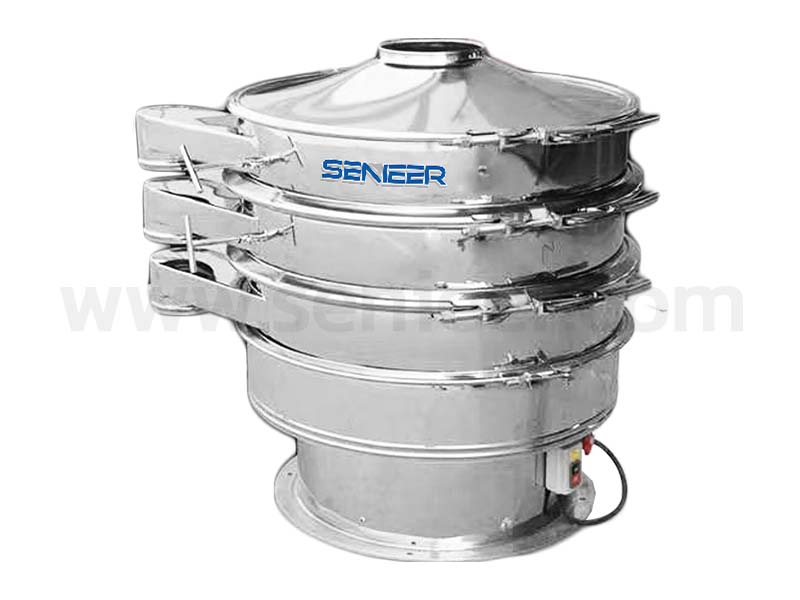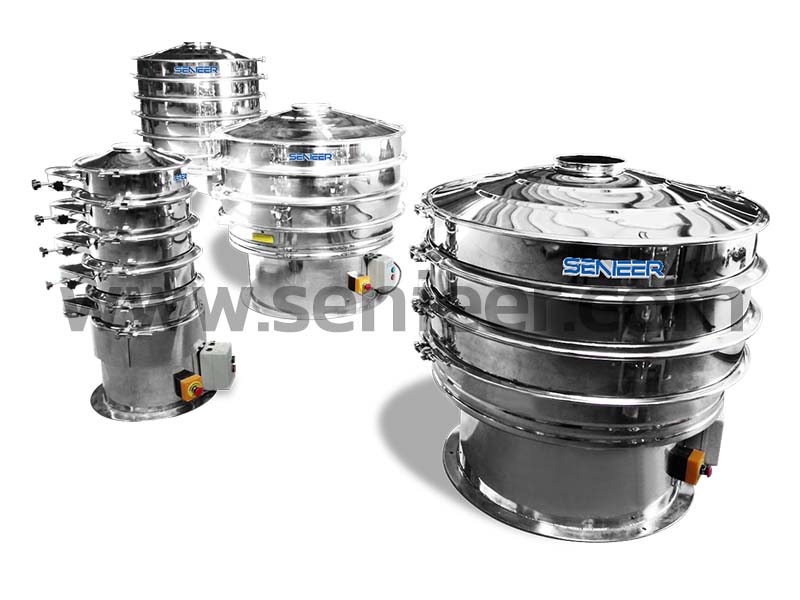Leakage of highly active drugs will seriously endanger the safety of operators – therefore, as more and more highly active compounds are approved as new drugs, pharmaceutical companies have more and more requirements for the closed production of tablet drugs . Drugs of OEB 3 level (OEL<100 µg/m3) need to be evaluated during the production process whether high-containment production is required, while drugs of OEB 4 (OEL<10 µg/m3) and OEB 5 (OEL<1 µg/m3) In the production process, highly airtight production equipment and technology must be applied. In this regard, this paper introduces the types of tablet sieves, analyzes the problems that should be considered when selecting the type of tablet sieves in the closed tablet pressing process, and compares the respective advantages of WIP sieves and CIP sieves.
Sieve machines can be divided into non-dust-tight type, dust-tight type, WIP type and CIP type, etc. Of these, non-dust-proof dust collectors are the most common type, but these sifters are not suitable for toxic or highly reactive formulations as they allow dust to escape during operation, especially if there is not enough air for dust collection in the case of. In addition, non-dust-tight machines also need to be disassembled and cleaned, which will expose operators or cleaning personnel to dust in the air.
Dust-proof sieves have positive connections to both upstream and downstream equipment and are fitted with gaskets and seals to prevent dust migration during operation. But like non-dust-tight sieves, they also need to be disassembled for cleaning and are not suitable for hazardous or highly reactive formulations. Therefore, to protect operators and cleaning personnel in hazardous applications, a wash-in-place (WIP) or clean-in-place (CIP) sieve machine must be used.

WIP sieves are dust and water resistant, providing an effective level of containment during operation. WIP machines allow water or water and detergent to be introduced into the machine and all areas within the machine will be fully wetted so no disassembly is required; the water will flush the entire interior of the machine, preventing dry powder exposure and removing most powder from the machine. This allows the operator or cleaning crew to safely disassemble the machine for final manual cleaning and drying without the risk of dust.
Like WIP sieves, CIP machines are dust and watertight and provide an effective level of containment during operation, but they require the use of effective cleaning procedures to verify that no material remains in the machine after cleaning. CIP machines can be completely cleaned and dried without disassembly. They require no human intervention, allowing the line to run on another product or batch as soon as the CIP machine has finished cleaning and drying.
Part 1 Factors To Consider When Choosing A WIP Or CIP Sieve
While WIP and CIP sieves cost more than dust-tight and non-dust-tight sieves, the additional cost of these two types of machines is usually a fraction of the cost of hermetic tablet presses and peripheral equipment. Since dust collectors can remove harmful dust from tablets, it is important to choose a suitable tablet sieving machine. The tablet sieve is also part of the closed system, and the tablet press, sieve and closed tank must work together seamlessly.
In order to adapt the sieve machine to actual production and needs, users need to customize its functions and operations. To do this, a User Requirements Specification (URS) should be developed to document all system expectations and approved by all user groups. Before purchasing a WIP or CIP sieve machine, users should consider the following questions:
What Is Our Normal Production Requirement?
How dangerous are our products? What is the Occupational Exposure Limit (OEL) range? What is the time-weighted average tolerable concentration for occupational exposure limits? Does the material require manual handling?
- Is the special sieve machine easy to assemble and disassemble?
- What layout do we need to handle upstream and downstream processes?
- How will we control the flow of water? Are there restrictions on water use?
- How will we manage the make-up air for dust collection?
- How will we handle equipment failure?
- Whether metal detection is required in the production process?
- Do we need a diverter for multiple tanks?
Normal Production Requirements
Determine the demand for capacity and dust removal efficiency, as well as the requirements for the relevant physical parameters of conventional sieving machines. This includes tablet size and shape, press production speed, press exit height, and barrel height.
Dangerous Product
Occupational exposure hazards for products and powders are classified into 5 levels, OEB 1 to 5, where 1 is the highest level for which exposure is permitted and 5 is the lowest level. The measurement unit of OEL level is μg/m3, 1000~5000 μg/m3 is OEB 1, and OEL<1 μg/m3 is OEB 5.
At this point, the WIP or CIP machine leak-tightness should be verified using the Standardized Measurement of Particle Concentration in Equipment (SMEPAC) guidelines. SMEPAC is a guideline sponsored by the International Society for Pharmaceutical Engineering (ISPE), which gives performance testing standards that allow pharmaceutical companies to accurately compare machines.
Assembly And Disassembly
Evaluate the ease of assembly and disassembly of the desired sieve. For example, are special tools and procedures required for disassembly and reassembly?
Layout
Consider the desired layout and determine how the machine will interface with upstream and downstream equipment, and how connections will be made and broken when the machine is dismantled and cleaned. These connections may be split butterfly valves, other closed valves, or continuous liner systems, each of which requires vertical space that must be accounted for in the layout. The tablet press connection, the discharge chute from the tablet press to the tablet sieve, the connection to the tablet sieve, metal detectors and tanks must all be WIP or CIP capable to ensure no dust escapes from the system.
Water Control And Use
Determine the discharge of water during a WIP or CIP process. Water usage is also a consideration, as pharmaceutical companies must collect some hazardous materials and dispose of them in hazardous waste collection facilities. By minimizing water usage, disposal costs can be kept low over the life of the machine. If off-line cleaning is to be performed, it must be determined how to disconnect the sieving machine from upstream and downstream equipment in a closed manner.

Dust Collection
Ensuring continuous dedusting in the sieve, with no fluctuations in flow and vacuum pressure throughout the batch, is necessary to maintain proper system performance. It should be determined in advance how the make-up air for dust collection will enter the sifter and what will happen if it fails. For example, if the sieve machine is positive pressure, will the positive pressure cause dust to be blown into the clean room?
Since the tablet press, sieve and hopper are all connected in series, there may be a separate dust collection system for the tablet press and sieve. Faced with this situation, the dust collection system must be properly balanced. If they are not balanced, the dust collection airflow of the tablet press is stronger than the dust collection airflow of the sieve machine, then the tablets may be pulled back into the tablet press. In addition, the dust airflow can cause problems for the tablets to flow out of the sieve machine and into the bin.
Equipment Failure
Determine how to handle all possible equipment failures. What is the company’s contingency plan in the event of a breakdown? What if the machine has to be opened during production? Does the company have a plan to safely open the machinery in an emergency using personal protective equipment?
Metal Detection
Determine the need for metal detection. Determine how to introduce the test piece of the metal detector in a closed manner. How to remove the test piece in a closed manner after it has passed through the metal detector? How to remove rejected pills from a metal detector in a closed fashion?
Shunt
Determine if a diverter is required at the discharge of the sieve machine. The splitter allows the use of multiple tanks to avoid shutting down the tablet press and screener when changing tanks.
Part 2 Comparison Between WIP Sieve And CIP Sieve
The main problem hindering automatic cleaning of sieve machines is that sieve machines have many nooks and crannies, and it is difficult for an automated system to clean them in a reviewable and fully verifiable manner. Therefore, WIP sieves are more common than CIP sieves.
In theory, CIP sieves appear to save cleaning time, but in reality, verifying the consistency of cleaning for each product is time-consuming, requiring electronic storage of the CIP recipe in the machine’s control system. Also, in addition to the cleaning process, the drying process needs to be validated to ensure that the sieve machine is completely dry before production starts again.
Part 3 Summary
The pharmaceutical industry is a highly regulated industry. When a pharmaceutical company produces or changes any product, it must report its production process to the State Drug Administration. This is an extremely tedious and complicated process, which will not only affect production efficiency, but also increase unnecessary losses for the enterprise. Therefore, when pharmaceutical companies choose WIP and CIP sieve machines, they need to fully consider how to make upstream and downstream equipment better compatible with each other, and do a lot of thinking and coordination to ensure their effectiveness. An experienced supplier of WIP and CIP sieve machines can help customers deploy a robust system that provides a high level of effective, trouble-free containment protection for their specific application.










